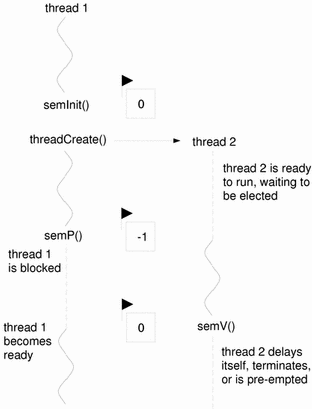Semaphores
A semaphore is an integer counter associated with a queue, possibly empty, of waiting threads. At initialization, the semaphore counter receives a user-defined positive or null value. Initialization is performed by invoking the following ChorusOS operating system service:
#include <chorus.h>
int semInit(KnSem* semaphore,
unsigned int count);
The semaphore parameter is the location of the semaphore and count is the semaphore counter. The semaphore must have been previously allocated by the user: allocation is not performed by the ChorusOS operating system. This implies that semaphores may be freely allocated by the user where convenient for his applications. As data structures representing semaphores are allocated by the applications, the ChorusOS operating system does not impose any limit on the maximum number of semaphores which may be used within the system.
Two atomic operations, named P and V, are provided on these semaphores.
#include <chorus.h>
int semP(KnSem* semaphore,
KnTimeVal* waitLimit);
semP() decrements the counter by one. If the counter reaches a negative value, the invoking thread is blocked and queued within the semaphore queue. Otherwise the thread continues its execution normally. The waitLimit parameter may be used to control how long the thread will stay queued. If waitLimit is set to K_NOTIMEOUT, the thread will stay blocked until the necessary V operation is performed. In the case of the thread being awakened due to the expiration of the period, a specific error code is returned as the result of the semP() invocation. In this case, the counter is incremented to compensate for the effect of the semP() operation.
#include <chorus.h> int semV(KnSem* semaphore);
semV() increments the counter by one. If the counter is still lower than or equal to zero, one of the waiting threads is picked up from the queue and awakened. If the counter is strictly greater than zero, there should be no thread waiting in the queue.
Figure 6-2 shows an example of two threads synchronizing by means of a semaphore.
Figure 6-2 Two Threads Synchronizing with a Semaphore

The following example is based on the previous one, but the two threads explicitly synchronize by means of a semaphore, so that the actor will eventually be destroyed when the created thread has done its job and as soon as it has done so. Refer to the semInit(2K) man page.
Example 6-3 Synchronizing Using Semaphores
(file: progov/semaphore.c)
#include <stdio.h>
#include <stdlib.h>
#include <chorus.h>
#define USER_STACK_SIZE (1024 * sizeof(long))
KnSem sampleSem; /* Semaphore allocated as global variable */
int
childCreate(KnPc entry)
{
KnActorPrivilege actorP;
KnDefaultStartInfo_f startInfo;
char* userStack;
int childLid = -1;
int res;
startInfo.dsType = K_DEFAULT_START_INFO;
startInfo.dsSystemStackSize = K_DEFAULT_STACK_SIZE;
res = actorPrivilege(K_MYACTOR, &actorP, NULL);
if (res != K_OK) {
printf("Cannot get the privilege of the actor, error %d\n", res);
exit(1);
}
if (actorP == K_SUPACTOR) {
startInfo.dsPrivilege = K_SUPTHREAD;
} else {
startInfo.dsPrivilege = K_USERTHREAD;
}
if (actorP != K_SUPACTOR) {
userStack = malloc(USER_STACK_SIZE);
if (userStack == NULL) {
printf("Cannot allocate user stack\n");
exit(1);
}
startInfo.dsUserStackPointer = userStack + USER_STACK_SIZE;
}
startInfo.dsEntry = entry;
res = threadCreate(K_MYACTOR, &childLid, K_ACTIVE, 0, &startInfo);
if (res != K_OK) {
printf("Cannot create the thread, error %d\n", res);
exit(1);
}
return childLid;
}
void
sampleThread()
{
int myThreadLi;
int res;
myThreadLi = threadSelf();
printf("I am the new thread. My thread identifier is: %d\n", myThreadLi);
res = semV(&sampleSem);
if (res != K_OK){
printf("Cannot perform the semV operation, error %d\n", res);
exit(1);
}
/* Suicide */
res = threadDelete(K_MYACTOR, K_MYSELF);
if (res != K_OK){
printf("Cannot suicide, error %d\n", res);
exit(1);
}
/* Should never reach this point! */
}
int main(int argc, char** argv, char**envp)
{
int myThreadLi;
int newThreadLi;
int res;
/*
* Initialize the semaphore to 0 so that
* the first semP() operation blocks.
*/
res = semInit(&sampleSem, 0);
if (res != K_OK) {
printf("Cannot initialize the semaphore, error %d\n", res);
exit(1);
}
newThreadLi = childCreate((KnPc)sampleThread);
myThreadLi = threadSelf();
printf("Parent thread identifier = %d, Child thread identifier = %d\n",
myThreadLi, newThreadLi);
/*
* Since semaphore has been initialized to 0
* this semP will block until a semV is performed
* by the created thread, letting the main thread know
* that created thread's job is done.
*/
res = semP(&sampleSem, K_NOTIMEOUT);
if (res != K_OK) {
printf("Cannot perform the semP operation, error %d\n", res);
exit(1);
}
/*
* Created thread has run and done all of its job.
* It is time to safely exit.
*/
return 0;
}
-
The semaphore sampleSem is allocated as global data of the actor. As the address space of the actor is shared by all threads running within the actor, both threads can freely access the semaphore in order to synchronize.
-
Avoid performing the semaphore initialization after having created the child thread. Depending on the scheduling, the second thread may start its execution as soon as it is created, and could reach the semV() operation before the semaphore has been initialized. Although the semV() could appear to work, semP() will never return due the fact that semInit() would reset the counter to 0.
-
The synchronization will work whatever the order in which the semP() and semV() operations are done. If semP() is done first, the counter will be set to -1 and the main thread will be blocked. The semV() will awake the main thread. If scheduling is reversed, the semV() will set the counter to 1, so that when the semP() operation occurs, the counter will be decremented to 0, but the thread will not block.
- © 2010, Oracle Corporation and/or its affiliates
